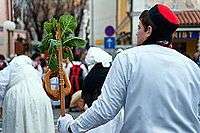Lika cap

The Lika cap (Croatian: Lička kapa, Serbian Cyrillic: Личка капа), also known as kićanka ("tassel"), is an important cultural symbol of the Lika region in Croatia,[1][2] part of the Lika national costume, traditionally worn by local Croats and Serbs.[a] The cap is cylinder-shaped with a flat top in red colour and the sides are black, and a black tassels often hangs down the back.
Origins
According to Supičić and Ivančević the Lika cap is a derivation of the Iapode headgear; During the Bronze Age, the Iapodes used a bronze sheet as the base of their cap, which was lined with textile or leather, and attached with a bronze fringe.[3][4] Of all short round caps, the Lika cap is the nearest to the caps seen on Illyrian bronze fragments.[5] The Slavic settlers adopted part of native Iapode culture, and part of their dress, such as the cap.[6]
History

During Habsburg rule over Croatia, the Austrians created buffer territories against the Ottoman Turks called the Croatian Military Frontier. Here they created a military police unit who were called the Seressaner (from the Latin meaning "tent dwellers"), made up of men from prosperous Lika families.[7] In Kordun, part of the Military Frontier, the Austrian military dress subsequently became part of the folk costume, however, the Lika cap was later adopted instead of the Austrian military cap.[8] The Serbs of White Carniola adopted the cap.[9]
The hajduks of Lika are said to have used this cap when fighting the Ottoman Turks. The regional origins of the cap demonstrates its affinity with other Dinaric styles, such as the Montenegrin cap and Šibenik cap. The Coat of arms of Croatia (šahovnica) is often adorned on the cap, while some older versions have repoussé designs on them. They are now worn mainly at festivals in full costume as well as national dances.
Traditions
When younger men are buried they wear a red Lika cap, while older men wear a black textile cap.[10]
See also
| Wikimedia Commons has media related to Lika cap. |
Annotations
- ^ Demographics of Lika: Before the Croatian War, according to the 1991 census, the Lika region (Otočac, Gospić, Korenica, Donji Lapac and Gračac municipalities) had 82,883 inhabitants:
- Serbs - 41.546 (50,12%)
- Croats - 37.719 (45,50%)
- Yugoslavs - 3.618 (4,38%)
References
- ↑ Skledar, Nikola. Simboli: socio-kulturni identitet, u Simboli identiteta, HED, 1991.
- ↑ Zavičajna Udruga Ličana: Vrilo Mudrosti, Slavonski Brod
- ↑ Supičić, Ivo (1999). Croatia in the Early Middle Ages. London: Philip Wilson. p. 58. ISBN 9780856674990.
- ↑ Ivančević, Radovan (1986). Art Treasures of Croatia. Motovun: IRO Motovun. p. 26. OCLC 18052634.
- ↑ Historijski arhiv u Karlovcu (1973). Zbornik. 5. pp. 206–207.
Od svih varijanata niske okrugle kape, ilirskim brončanim fragmentima najbliža je današnja muška licka kapa kićanka. Iznenađuje nas pojava da u vremenski tako udaljenom rasponu na istom tlu još uvijek Živi i postoji istovrsni karakteristični ... Sve lokalne varijante crvenkapa ...
- ↑ Zavičaj: kalendar. Matica iseljenika Srbije. 1960. p. 66.
Онда су дошли Словени, попримили део културе ‚Тапода и нешто од ъъихове ношъье (личка капа).
- ↑ David Hollins (2005). Austrian Frontier Troops 1740-98. Osprey Publishing. pp. 34–35. ISBN 978-1-84176-701-7.
- ↑ Vladimir Dvorniković (1939). Карактерологија југословена. Космос. p. 462.
Касније је и на Граници личка капа истиснула аустриску војничку
- ↑ Etnografski institut (1989). ГЕИ. 38-40. Научно дело. p. 27.
додатак у ношньи je личка капа
- ↑ Mara Hećimović-Seselja (1985), Tradicijski život i kultura ličkoga sela: Ivčević Kosa, p. 174,
Momku se oblači roba za mašu, udat im ženama i starijim muškarcima oblači se zakonska (vjenčana) roba. Na noge mrtvacu obuvaju se čarape. Mladim muškarcima stavlja se crvena lička kapa na glavu, dok stariji muškarci u grob nose crnu suknenu kapu...